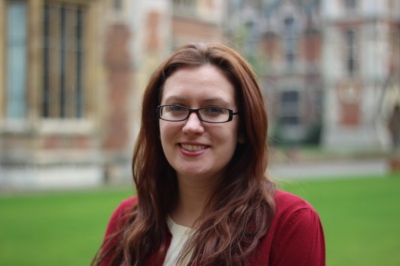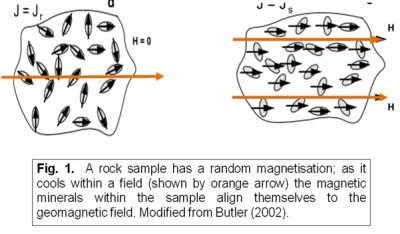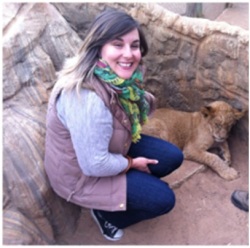Beth Singler is a PhD candidate in Theology and Religious Studies at the University of Cambridge. Unlike the majority of PhDs in her faculty who are interested in long dead Theologians, difficult questions about the nature of god or translating dusty texts, Beth is researching contemporary religious movements online. In particular her thesis is on the Indigo Children, an idea from what is often called the New Age Movement.
AA: So, tell us a little bit about your work:
BS: I’m very interested in New Religious Movements (NRMs), in particular those that have a strong online presence. A lot of NRMs do now interact primarily online because their ideas might not be accepted by the mainstream, or indeed, they might be ridiculed for them, and the Internet enables people who self-identify in new ways to find each other. For my PhD thesis I am looking at the Indigo Children who might not be entirely defined as a religious movement, but are definitely a new community of self-identifying people who communicate regularly through social media about their spiritual ideas.
AA: Okay, now you must know what the next question is going to be… what are ‘Indigo Children’?
BS: You surprise me! Briefly, the Indigo Children are seen by some as a special generation of children who started being born in the early 80s. They were identified by a woman called Nancy Ann Tappe who claimed to be a synsthete (seeing colours instead of other sensory input) and a clairvoyant. She said that she saw people’s “life colours” and that each one defined a progressive state in humankind’s evolution. Others have taken Tappe’s idea and described Indigos and their problems further, as well as exploring new iterations such as Crystals, Rainbows, Dolphins, Blue Rays, Platinums, Angels on Earth, Starseeds, Beautiful Silent Ones, etc etc.
Although called Indigo “Children”, Indigos can be small children, teenagers or adults. And there are also those who were born prior to the 1980s who see themselves as Elder Indigos, or forerunners of the explosion in numbers (especially those who involved themselves with the counter-cultural revolution of the 1960s). Many indidivuals don’t seem to know that they ARE Indigo Children until they come across the term online, or a friend mentions it, and then their difficulties with fitting into structures and systems suddenly make sense.
AA: You mention that a lot of these individuals do not know they are ‘Indigos’. Is there a list of criteria or certain traits that identify them?
BS: Nancy Ann Tappe gave us a check-list of sorts for the traits of Indigo Children. It has been elaborated upon by subsequent writers, and version proliferate online, but it serves as a starting point. I won’t quote all of it, but here are a few of the 8 points:
“•They are very intelligent, and very oriented toward their purpose on earth.
•They come into the world with a feeling of royalty (and often act like it).
•They often have lots of energy.”
The full list, and later versions, describe a combination of a sense of entitlement and social awkwardness that can be seen or diagnosed by others as behavioural problems or ‘special needs’, and Indigos may have problems fitting into society’s main structures such as education and the workplace. Seeing Indigos as ‘problem children’ or ‘children who just don’t fit in’ arguably provides answers for both parents and those who begin to identify as Indigos in adulthood. The former then have a reason for their child’s behavioural problems and can hold them up as ‘special’, and the latter also now have an explanation for their difficult or even traumatic childhood. For both, finding the Indigo concept can be like a moment of revelation, or even conversion. Many of the Indigos I have interviewed describe how reading about the Indigo Children was like finding out something that they knew all along, but had never had a name for before.
AA: What was it that interested you in particular about Indigo children? Why did you choose to focus on them for your research project?
I’m very interested in the adoption and adaption of established discourses and narratives for spiritual ends. So in the case of the Indigo Children there is a mix of scientific theory, evolutionary theory, spiritualism, conspiricism and utopianism that picks up from more older sources. Contemporary religion (or spirituality, and the difference is a part of a huge debate I can’t go into here) does seem to engage in more creative play with sources in the 20th and 21st Centuries. And some of my other research is on more consciously ‘invented’ religions, to use Cusack’s (2010) term, such as Jediism and some more obscure online forms.
AA: I expect those who subscribe to this view of their children or themselves as Indigo face a lot of skepticism. (I’ll admit to being skeptical myself.) How do you approach your research on a subject like this, especially the interviews?
One of the first Indigos I interviewed asked me if I was just going to “call them all a ‘bunch of whackos’?”. Well, apart from the fact that a one sentence PhD thesis is pretty rubbish, I happen to think that they are acting in an eminently rational way that humankind has used for centuries. You can call it at its basic level ‘making sense’, or to use a fancy religious studies idea, that they are creating theodicies, ideas produced in order to understand the presence of evil in the world. Evil as in the problems that they face every day. Understanding where and how these ideas come about is far more interesting to me than whether they are right or not.
Also, as a social anthropologist it is never my place to interrogate the truth of person’s ‘making sense’. Personally, as what you might call a militant agnostic, I’d also say my mind is so open-minded I’m at risk of it falling out!
AA: If you could share one particular aspect of your research with others (so far) what would you want them to know about either New Age Movements, or Indigo children, or this type of research?
I think that the main aim of my work – which may seem surprising since I research these seemingly exotic evolved psychic children, Jedi, pagans, Scientologists and many other forms of online created spiritualities – is to show how mundane the rational processes they are engaging in actually are. I propose that they are merely people being people to each other, for good or ill.
AA: Thank you so much for taking part in Penny University and sharing your research with everyone. I imagine there’s now going to be a Google stat spike in searched for ‘Indigo children’.
Beth Singler is a PhD student at the University of Cambridge specializing in the social anthropological study of New Religious Movements online. Combining traditional fieldwork with digital ethnography, Beth explores the new definitions of self that multiple on the Internet. Her PhD is on the Indigo Children, but she has also written about Wiccans, Jedi, Scientologists, pop-culture religions and various online subcultures. She has her own blog at http://bvlsingler.wordpress.com/ and you can follow her on Twitter via @BVLSingler.








